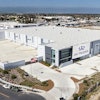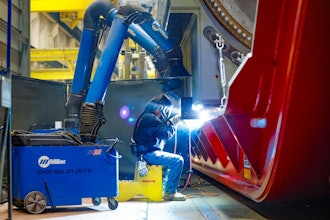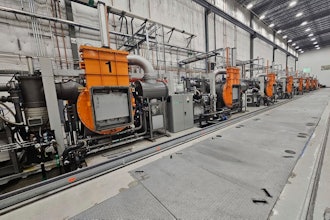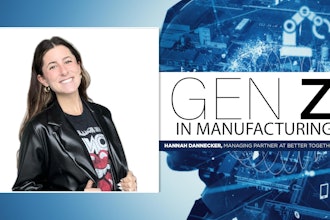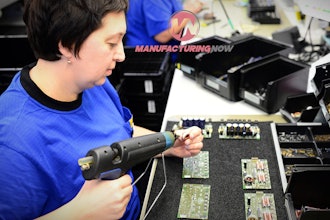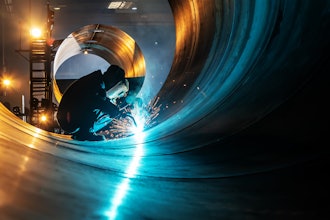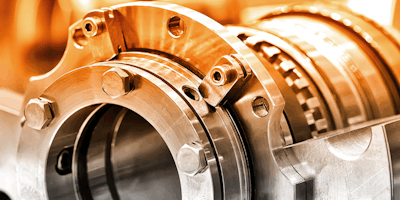
Infor
A Brave New World
for Machinery Makers
Global competition, rising customer demands,
and new business models pose challenges
U sers of industrial machinery and equipment (IM&E) are locating new facilities with new capabilities around the globe — and are demanding that machine-
makers follow them. The industrialization of emerging nations has increased demand
for both infrastructure projects (e.g., roads, utilities, buildings, plants) and production
equipment around the world. To remain competitive, IM&E manufacturers must
develop, source, produce, and service products in new markets — or watch their
market shares and profits decline.
Global complexities in every region
IM&E is an intensely competitive global marketplace, valued at approximately
$3.84 trillion.1 The United States alone exported more than $139 billion worth
of machinery in 2015, and welcomed vast amounts of machinery from China
($30.6 billion), Japan ($21.7 billion), and Germany ($19.3 billion).2 Even in their
domestic markets, IM&E manufacturers are likely to face substantial foreign competition.
IM&E manufacturing is also a complex market, requiring advanced technical skills
and significant expenditures on R&D, production equipment, and service functions.
As the use of Internet of Things (IoT) technologies and telemetry increase, the
industry’s reliance on high-tech is also rising — creating new engineering, electronics,
and information technology demands. New competitors in low-cost countries are
creating pricing pressures for existing IM&E companies — and threatening their
ability to invest in their futures.
Increasing regulation also offers a major challenge. Although some countries are
trying to harmonize machine safety standards (governed by the International
Organization for Standardization and International Electrotechnical Commission),
varied regional and country standards remain in place. Compliance is complicated
because while these standards are technically voluntary in many countries, they are
typically used as practical interpretation for industry regulations.3
A Brave New World for Machinery Makers ©2016 The MPI Group 1
Quick Report
1 Global Machinery Report, Euler Hermes, Feb. 2, 2016.
2 Clean International Trade Administration, U.S. Department of Commerce.
3 Rockwell Automation.
To remain
competitive,
IM&E
manufacturers
must develop,
source,
produce,
and service
products in
new markets
— or watch
their market
shares and
profits decline.
Engineer-
to-order and
customized
projects are
now the norm
in many
IM&E markets.
IM&E responsibilities for regulations and standards extend well beyond the
equipment itself. Safety signs and symbols on machinery must be translated into
local languages, and updated regularly to remain compliant with evolving requirements.
Varied operating environments (e.g., arid deserts, tropical rainforests, frigid tundra)
require equipment customizations. Global logistics also pose obstacles; equipment
transported via highway must be adapted to fit local jurisdictions (e.g., road widths
can vary by country, sometimes requiring that equipment be sized to local
transportation standards).
Even more difficult is the fact that IM&E manufacturers must account for the product’s
entire lifecycle across the supply chain, ensuring not just quality and service for
finished equipment, but sourcing certifications for the components, materials, and
software that go into machines. For example, Conflict Minerals regulations prevent
the use of minerals, such as gold and tantalum from countries that use their sale
to fund aggression (e.g., Democratic Republic of Congo). These minerals are vital
to machinery products, yet may not be tracked by smaller-tier suppliers — putting
IM&E companies at risk.
Increasingly complex customer requests
Customers are even more demanding than regulators. For example, machines
ordered by two customers may look similar, but can have dramatically different
modes of operation and components depending on the customers’ discrete requests
and their markets of use, such as cab preferences or preferred safety features.
Engineer-to-order and customized projects are now the norm in many IM&E
markets; the challenge is to maintain profitability while developing products for
multiple markets of one.
At the same time, IM&E manufacturers must integrate new technologies and
materials into products to remain competitive. Customers want to capture and
communicate real-time information to enterprise systems and applications
(e.g., analytics, asset management) via the IoT for assets that include (among others):
• Mining equipment that communicates weight loads and other performance
characteristics to remote operators, who then make data-based decisions
• Stamping presses that report and optimize energy draws, controlling energy costs
and allowing maintenance to react to dubious surges in power consumption
• Molding machines that detect and adjust to quality variances, reducing waste and
improving productivity; monitor safety protocols; and sense maintenance needs.
2 ©2016 The MPI Group A Brave New World for Machinery Makers
Machine-makers are responsible not only for embedding intelligent sensors and
controls in equipment, but also for training customers on how to leverage new
IoT capabilities.
These new product requirements are stressing IM&E production and supply-chain
performances. Although the average cycle time in the industrial machinery industry
has declined by 12 percent over the last three years — machines are being made
faster — those times remain high compared to comparable industry sectors, such
as transportation equipment (123 hours for industrial machinery vs. 66 hours for
transportation equipment). This represents an opportunity to streamline IM&E
production — and increase capacity to support growth.4 But speeding up production
will require deeper implementations of improvement methodologies (e.g., lean
manufacturing) as well as better coordination of complex supply chains via
real-time sharing of demand signals and product development data. The made-to-
order/engineer-to-order nature of IM&E also requires collaboration with customers
and corporate functions (e.g., R&D, materials development, procurement) on highly
specialized engineering demands.
From goods to services
As IM&E customers seek to reduce costs, many look to IM&E manufacturers
to manage development and installation of production lines, integrate and service
equipment from competing IM&E companies, and even manage entire facilities
(manufacturing, chemical, mining, etc.). A machine-maker may, in fact, have
no products in a given facility, yet still serve as project coordinator for management,
service, and support for the entire installation. For some firms, this work offers
a new revenue stream, but it also requires skills that many IM&E manufacturers
don’t have — and investments that many can’t make.
Developing advanced MRO (maintenance, repair, and operations) infrastructures
can be especially lucrative. Aftermarket service is a new revenue stream and profit
center for IM&E companies, helping to close sales for new equipment at low
margins in exchange for lengthy service contracts. For example, 56 percent of
construction machinery OEMs in Europe cite the importance of aftermarket
service as a top industry trend, second only to a shift in demand to markets
beyond Europe.5
A Brave New World for Machinery Makers ©2016 The MPI Group 3
4 MPI Manufacturing Study, The MPI Group, 2015.
5 Anna Granskog, Benny Guttman, and Erik Sjödin, “Toward a customer-centric construction-equipment Industry,”
McKinsey & Company, April 2016.
Aftermarket
service is a
new revenue
stream and
profit center
for IM&E
companies,
helping to
close sales for
new equipment
at low margins
in exchange
for lengthy
service
contracts.
Equipment service capabilities, however, require deep understanding of customer
expectations and advanced facility, staff, and logistics planning. Can an IM&E
manufacturer extend services to the corners of the globe and maintain customers’
equipment to high standards? And how can repairs be managed most cost-effectively —
onsite or depot repair?
New customer relationships
Customer expectations about equipment ownership are changing, too, as many
choose to lease — or simply pay hourly rates for machine uptime. For example,
of equipment that was financed in 2015 in the United States, a full 39 percent was
leased — up from 17 percent of the total value of financed equipment acquisitions
in 2011.6 IM&E manufacturers face significant decisions as they increasingly retain
ownership of machines based at customer sites:
• Longevity: If an IM&E manufacturer retains ownership, it’s imperative to design
machines that last longer — or that can be refurbished and upgraded for re-use.
But how much extra cost is worthwhile?
• Reclamation: When machines can’t be refurbished, materials and components can be
reclaimed and re-used in new products. How should recycling needs impact product
design and supplier sourcing?
• MRO awareness: IM&E manufacturers need to fully comprehend how customers
operate leased equipment. Can machine-makers digitally connect with customer
systems to track usage, performance, and maintenance records?
Grow revenues and profits despite challenges
IM&E manufacturers face massive challenges. Savvy executives are navigating
this new competitive landscape by:
• Leveraging business intelligence: IM&E manufacturers now collect detailed data of
actual performance from equipment in use at customer locations. With it, IM&E
manufacturers learn how and why customers use products, helping to identify new
opportunities to serve customers and improve next-generation machine designs.
4 ©2016 The MPI Group A Brave New World for Machinery Makers
6 State of the Equipment Finance Industry, Equipment Leasing and Finance Foundation.
About The MPI Group. The MPI Group serves leaders with research, advice, and performance-targeted solutions that
provide a competitive advantage in today’s fierce marketplace. MPI combines the disciplines of research, strategic
advice, knowledge development, and hands-on leadership to create a difference — in performance, in profits, and
in the people who make them possible. www.mpi-group.com
A Brave New World for Machinery Makers ©2016 The MPI Group 5
• Developing a strategy to maximize market share and margins: It’s no longer enough to
deliver great equipment. Customers ask for so much more — system design, setup,
and installation; maintenance and repair; leasing and operation options; etc. IM&E
executives must craft a combination of products, services, and ownership options
that boost sales and profit margins while deepening relationships with customers.
• Improving the organization: Competitive pressures are forcing IM&E manufacturers
to boost the quality and speed of every process, from product development to
operations to service. This requires strong leadership and significant investments
in new skillsets (e.g., IoT, MRO); process improvements; new capabilities
(e.g., additive manufacturing, information technology); and advanced business
systems and software solutions.
IM&E manufacturers face diverse global challenges. Leading machine-makers
turn these into opportunities to grow markets and expand revenues and profits.
IM&E executives must craft a combination of products, services,
and ownership options that boost sales and profit margins
while deepening relationships with customers.

